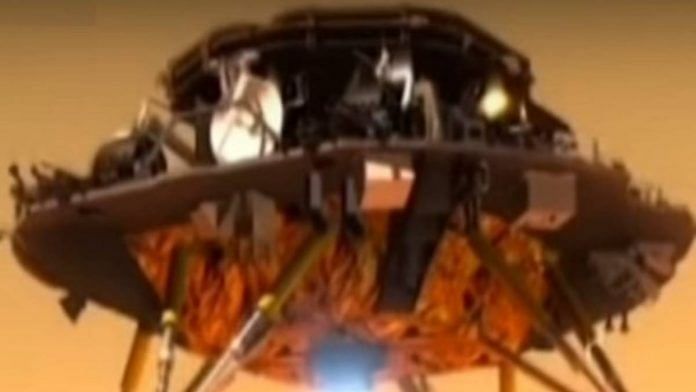Bengaluru: China successfully landed the Zhurong rover on Mars Saturday, making it the country’s first landing on another planet and the third country to perform a successful soft landing successfully on Mars, after the former Soviet Union and the USA.
The rover is a part of the Tianwen-1 mission, which entered the orbit around Mars in February.
The lander, with the rover attached, touched down in Utopia Planitia, in the northern hemisphere of Mars – a large, vast plain that was once thought to have been an ancient ocean. The lander has currently deployed its solar panels, and is expected to release the rover within a week.
The Zhurong rover, just like NASA’s currently active rovers on Mars, is also primarily astrobiological in nature – which means that it will search for present, or most importantly, past life on the planet. It will range on the surface, powered by solar panels, and probe the surface and subsurface of the planet, performing in-situ chemical analyses on soil composition, while also hunting for biosignatures for any past life or habitability.
It is also considered to be a precursor to the sample return mission that China plans for the 2030s and is expected to function for at least three months.
The first spacecraft to land on Mars successfully was Mars 3, launched by the Soviet Union in 1971. It, however, stopped transmitting after just 110 seconds. Russia has not had a successful landing since. The European Union (EU) has also attempted to land on Mars, but not been successful yet.
There are currently fourteen spacecraft working on or around Mars. These include eight orbiters, two landers, three rovers – including Zhurong, and one helicopter.
Also read: Why a giant piece of Chinese rocket is set to hit Earth & what could happen when it does
Zhurong’s objectives and design
The rover is equipped with six scientific payloads including a ground penetrating radar, multi spectral and topography cameras, magnetic field detectors, and weather instruments. Together with the orbiter, there are a total of 13 payloads that will help study the geology and surface composition of Mars, underground layers of soil, the internal structure of the planet, the weather and climate, the ionosphere, and the planet’s barely remnant magnetic field.
The mission is both astrobiological, in nature, and is a technology demonstrator as well. Zhurong will also cache and store rock and soil samples for China’s upcoming planned sample return missions in the 2030s.
The rover performed its landing with a similar “seven minutes of terror”, as had the NASA landers, when the autonomous landing worked itself out in its most crucial stage nearly 350 million km away, with an 18-minute delay in signal reception and no human intervention. The landing took place with the expected assistance of a heat shield and a parachute.
The landing platform that houses the rover, fired its retro thrusters just before the final descent, and the final spot of touchdown was chosen autonomously based on real time data from terrain navigation and altitude cameras.
The rover will move around on six sturdy wheels and is expected to function for a minimum of three months.
Also read: ‘Paper sensor’ developed by IIT Madras could help detect & monitor antimicrobial pollutants
The landing site
Utopia Planitia is the site of an ancient ocean on Mars, back when the planet was covered with liquid water, billions of years ago, much like the Earth is today. The site consists of layers and layers of sedimentary soil that could reveal crucial information about the presence of water — and any possibility of past life.
Water is considered to be a key component in our hunt for any forms of life outside the Earth, owing to its ability to dissolve and transport a wide variety of nutrients and minerals, its ability to remain liquid over a wide range of pressures and temperatures, and more.
The ground penetrating radar on board the rover will look for pockets of salt water and water ice below the surface in this region, studying the location in two different frequencies for depths of up to 33 feet. Such pockets of water and ice under the surface are important finds, as they would be protected against the dangerous radiation that bathes the planet’s surface, and could potentially be a habitat for microscopic lifeforms.
(Edited by Poulomi Banerjee)
Also read: Polish researchers discover a pregnant Egyptian mummy, in a first



